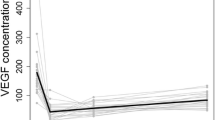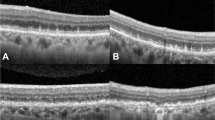Abstract
Purpose
To determine brain-derived neurotrophic factor (BDNF) levels in the serum and aqueous humor (AH) and assess the relationship between BDNF levels and the thickness of the macular ganglion cell-inner plexiform layer (GCIPL) in macular telangiectasia type 2 (MacTel).
Methods
This study included 25 patients with MacTel (MacTel group) and 25 control subjects (control group). The levels of BDNF in the serum and AH were tested using an enzyme-binding immunosorbent assay. GCIPL thickness was measured by segmentation analysis using optical coherence tomography (OCT).
Results
There was no significant difference in the mean serum BDNF levels between the MacTel and control groups (p = 0.145). The average BDNF level in the AH was significantly lower than that in the control group (p = 0.026). OCT segmentation analyses revealed that the minimum GCIPL thickness was significantly lower in the MacTel group than in the control group (p = 0.039). In the correlation analysis of BDNF levels with GCIPL thickness, significant correlations existed between the BDNF level of the AH and minimum GCIPL thickness in the MacTel group.
Conclusion
The concentration of BDNF in the AH was decreased in the MacTel group, and this reduction was related to the minimum GCIPL thickness. The low BDNF levels detected in the MacTel group may have resulted in thinning of the GCIPL due to the loss of retinal ganglion cells.


Similar content being viewed by others
Data and material availability
All relevant data are included in the manuscript.
References
Jhingan M, Marsonia K, Shukla D, Rosenfeld PJ, Chhablani J (2017) Idopathic macular telangiectasis type 2 and co-existent diabetic retinopathy. Int J Retina Vitreous 3:50
Christakis PG, Fine HF, Wiley HE (2019) The diagnosis and management of macular telangiectasia. Opthalmic Surg Lasers Imaging Retina 50(3):139–144
Sauer L, Gensure RH, Hammer M, Bernstein PS (2018) Fluorescence lifetime imaging ophthalmoscopy : a novel way to assess macular telangiectasia type 2. Ophthalmol Retina 2(6):587–598
Stem MS, Gardner TW (2013) Neurodegeneration in the pathogenesis of diabetic retinopathy: molecular mechanisms and therapeutic implications. Curr Med Chem 20(26):3241–3250
Feng L, Chen H, Yi J et al (2016) Long-term protection of retinal ganglion cells and visual function by BDNF in mice with ocular hypertension. Investig Ophthalmol Vis Sci 57(8):3793–3802
Dai M, Xia XB, Xiong SQ (2012) BDNF regulates GLAST and glutamine synthetase in mouse retinal Müller cells. J Cell Physiol 227:596–603
Ghaffariyeh A, Honarpisheh N, Shakiba Y et al (2009) Brain-derived neurotrophic factor in patients with normal-tension glaucoma. Optometry 80(11):635–638
Inanc M, Sekeroglu MA, Demirtas C et al (2018) Brain-derived neurotrophic factor in patients with age-related macular degeneration and its correlation with retinal layer thickness. Investig Ophthalmol Vis Sci 59(7):2833–2840
Shpak AA, Gekht AB, Druzhkova TA, Kozlova KI, Gulyaeva NV (2018) Brain-derived neurotrophic factor in patients with primary open-angle glaucoma and age-related cataract. Curr Eye Res 43(2):224–231
Uzel AG, Uğurlu N, Toklu Y et al (2020) Relationship between stages of diabetic retinopathy and levels of brain-derived neurotrophic factor in aqueous humor and serum. Retina 40(1):121–125
Pierro L, Gagliardi M, Iuliano L et al (2012) Retinal nerve fiber layer thickness reproducibility using seven different OCT instruments. Investiig Ophthalmol Vis Sci 53(9):5912–5920
Chhablani J, Rao HB, Begum VU et al (2015) Retinal ganglion cells thinning in eyes with nonproliferative idiopathic macular telangiectasia type 2A. Invest Ophthalmol Vis Sci 56(2):1416–1422
Yoon CK, Yu HG (2018) Ganglion cell-inner plexiform layer and retinal nerve fiber later changes within the macula in retinitis pigmentosa: a spectral domain optical coherence tomography study. Acta Ophthalmol 96(2):180–188
Tamhance M, Cabrera-Ghayouri S, Abelian G, Viswanath V (2019) Review of biomarkers in ocular matrices: challenges and opportunities. Pharm Res 36(3):40
Benarroch EE (2015) Brain-derived neurotrophic factor: Regulation, effects, and potential clinical relevance. Neurology 84(16):1693–1704
Erickson KI, Prakash RS, Voss MW et al (2010) Brain-derived neurotrophic factors is associated with age-related decline in hippocampal volume. J Neurosci 30(15):5368–5375
Bathina S, Das UN (2015) Brain-derived neurotrophic factor and its clinical implications. Arch Med Sci 11(6):1164–1178
Azevedo KPM, de Oliveira VH, Medeiros GCBS et al (2020) The effects of exercise on BDNF levels in adolescents: a systematic review with meta-analysis. Int J Environ Res Public Health 17(17):6056
Laske C, Banschbach S, Stransky E et al (2010) Exercise-induced normalization of decreased BDNF serum concentration in elderly women with remitted major depression. Int J Neuropsychopharmacol 13(5):595–602
Kaviarasan K, Jithu M, ArifMulla M et al (2015) Low blood and vitreal BDNF, LXA4 and altered Th1/Th2 cytokine balance are potential risk factors for diabetic retinopathy. Metab Clin Exp 64:958–966
Sung MS, Yoon JH, Park SW (2014) Diagnostic validity of macular ganglion cell-inner plexiform layer thickness deviation map algorithm using cirrus HD-OCT in preperimetric and early glaucoma. J Glaucoma 23:144–151
Park KA, Park DY, Oh SY (2011) Analysis of spectral-domain optical coherence tomography measurements in amblyopia: a pilot study. Br J Ophthalmol 95:1700–1706
Powner MB, Gillies MC, Zhu M, Vevis K, Hunyor AP, Fruttiger M (2013) Loss of M¨uller’s cells and photoreceptors in macular telangiectasia type 2. Ophthalmology 120:2344–2352
Noma H, Funatsu H, Mimura T, Harino S, Hori S (2010) Aqueous humor levels of vasoactive molecules correlate with vitreous levels and macular edema in central retinal vein occlusion. Eur J Ophthalmol 20:402–409
Funding
This study was supported by a research fund from Chosun University Hospital, 2021.
Author information
Authors and Affiliations
Contributions
ST Kim designed the study, JY Yu and DE Jeong participated in sample collection, and JY Joo and ST Kim analyzed the obtained data. All authors have read and approved the final manuscript.
Corresponding author
Ethics declarations
Competing interests
Authors have no potential conflict of interest to declare.
Ethics approval
The Institutional Review Board Ethics Committee of the Chosun University Hospital approved this study.
Consent to participate
Written informed consent was obtained from all study participants.
Additional information
Publisher's Note
Springer Nature remains neutral with regard to jurisdictional claims in published maps and institutional affiliations.
Supplementary Information
Below is the link to the electronic supplementary material.
Rights and permissions
Springer Nature or its licensor (e.g. a society or other partner) holds exclusive rights to this article under a publishing agreement with the author(s) or other rightsholder(s); author self-archiving of the accepted manuscript version of this article is solely governed by the terms of such publishing agreement and applicable law.
About this article
Cite this article
Yu, J.Y., Jeong, D.E., Joo, J.Y. et al. Brain-derived neurotrophic factor levels and macular ganglion cell-inner plexiform layer thickness in macular telangiectasia type 2. Int Ophthalmol 43, 1927–1933 (2023). https://doi.org/10.1007/s10792-022-02592-z
Received:
Accepted:
Published:
Issue Date:
DOI: https://doi.org/10.1007/s10792-022-02592-z




